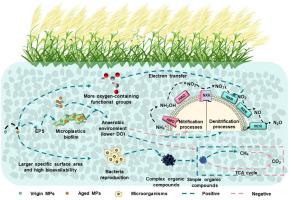人工湿地中老化微塑料的威胁加剧:对氮循环和温室气体排放的影响
IF 12.4
1区 环境科学与生态学
Q1 ENGINEERING, ENVIRONMENTAL
引用次数: 0
摘要
微塑料(MPs)对人工湿地的污染物处理性能有显著影响。然而,老化MPs对CWs内氮(N)和温室气体(GHG)排放的影响仍然有限。本研究以湿地中广泛分布的纤维状MPs为代表,探讨不同浓度和老化行为对n转化和温室气体排放的影响。结果表明,高浓度的老化MPs降低了氨氧化菌的丰度,同时促进了硝酸盐还原菌的丰度,导致NH₄⁺-N的去除率降低(12.85%),NO₃⁻-N的去除率增加(39.44%)。此外,MPs通过细胞壁进入植物体内,影响植物生长,诱导氧化应激,从而降低植物对氮的吸收能力。此外,高浓度老化MPs通过改变与N和C转化相关的酶活性和功能基因,增加N2O和CH4的排放,同时抑制CO2的排放。这些研究结果强调了基质中MPs的积累和老化会显著影响化学废物的运行和去除污染物的性能。本文章由计算机程序翻译,如有差异,请以英文原文为准。

Heightened Threat of Aged Microplastics in Constructed Wetlands: Impacts on Nitrogen Cycles and Greenhouse Gas Emissions
Microplastics (MPs) could significantly affect the pollutant treatment performance of constructed wetlands (CWs). However, the impact of aged MPs on nitrogen (N) and greenhouse gas (GHG) emissions within CWs remains limited. This study utilized fibrous MPs, which were widely distributed in wetlands, as representative MPs to explore the effects of different concentrations and aging behaviors of MPs on N–transformation and GHG emissions. The results revealed that high–concentration aged MPs reduced the abundance of ammonia-oxidizing bacteria while promoting the abundance of nitrate–reducing bacteria, leading to a decrease in NH₄⁺-N removal (12.85%) and an increase in NO₃⁻-N removal (39.44%). Furthermore, MPs entered plants through their cell walls, affecting plant growth and inducing oxidative stress, thereby reducing the plants ability to absorb N. Additionally, high–concentration aged MPs enhanced the emission of N2O and CH4 by altering the enzymatic activities and functional genes associated with N and C transformation, while inhibiting CO2 emission. These findings emphasize that the accumulation and aging of MPs within substrate could significantly influence the operation and pollutants removal performance of CWs.
求助全文
通过发布文献求助,成功后即可免费获取论文全文。
去求助
来源期刊

Water Research
环境科学-工程:环境
CiteScore
20.80
自引率
9.40%
发文量
1307
审稿时长
38 days
期刊介绍:
Water Research, along with its open access companion journal Water Research X, serves as a platform for publishing original research papers covering various aspects of the science and technology related to the anthropogenic water cycle, water quality, and its management worldwide. The audience targeted by the journal comprises biologists, chemical engineers, chemists, civil engineers, environmental engineers, limnologists, and microbiologists. The scope of the journal include:
•Treatment processes for water and wastewaters (municipal, agricultural, industrial, and on-site treatment), including resource recovery and residuals management;
•Urban hydrology including sewer systems, stormwater management, and green infrastructure;
•Drinking water treatment and distribution;
•Potable and non-potable water reuse;
•Sanitation, public health, and risk assessment;
•Anaerobic digestion, solid and hazardous waste management, including source characterization and the effects and control of leachates and gaseous emissions;
•Contaminants (chemical, microbial, anthropogenic particles such as nanoparticles or microplastics) and related water quality sensing, monitoring, fate, and assessment;
•Anthropogenic impacts on inland, tidal, coastal and urban waters, focusing on surface and ground waters, and point and non-point sources of pollution;
•Environmental restoration, linked to surface water, groundwater and groundwater remediation;
•Analysis of the interfaces between sediments and water, and between water and atmosphere, focusing specifically on anthropogenic impacts;
•Mathematical modelling, systems analysis, machine learning, and beneficial use of big data related to the anthropogenic water cycle;
•Socio-economic, policy, and regulations studies.
 求助内容:
求助内容: 应助结果提醒方式:
应助结果提醒方式:


